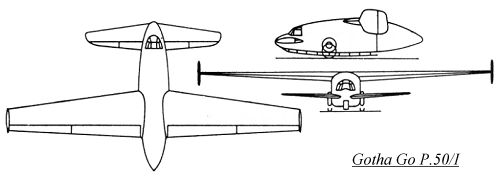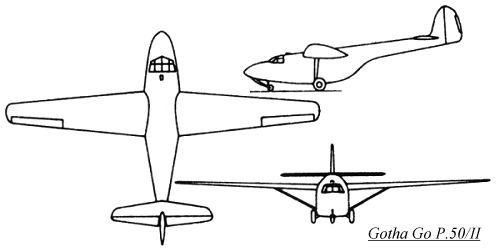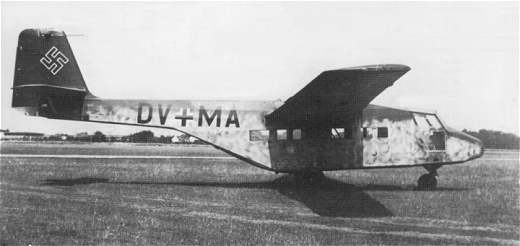Gotha Go P.50
The Gotha P.50
was designed after the RLM issued a contract for a new transport glider
in 1939, which could carry twelve fully-equipped troops, a Kubelwagen or
a cannon. Two versions were designed, the first version was very unorthodox
looking and the second was of a much more conventional layout. Both versions
featured a rear loading ramp.
 The first version had a short, squat fuselage, with a shoulder mounted,
tapered wing placed near the rear. A fin and rudder was located on each
end of the main wing, and a fairly long, forward stabilizer (canard) with
elevators was mounted in the forward mid-fusleage position. The rear fuselage
section swung up for loading, a feature that was later used on the Gotha
Go 242/244 transport glider/transport aircraft. Takeoff and landing was
done on two main wheels and a long skid that ran the length of the fuselage.
A crew of two sat above the forward canard wing. This design was felt to
be too unconventional to be built as a front line aircraft.
The first version had a short, squat fuselage, with a shoulder mounted,
tapered wing placed near the rear. A fin and rudder was located on each
end of the main wing, and a fairly long, forward stabilizer (canard) with
elevators was mounted in the forward mid-fusleage position. The rear fuselage
section swung up for loading, a feature that was later used on the Gotha
Go 242/244 transport glider/transport aircraft. Takeoff and landing was
done on two main wheels and a long skid that ran the length of the fuselage.
A crew of two sat above the forward canard wing. This design was felt to
be too unconventional to be built as a front line aircraft.
 The more orthodox second design featured a boxy fuselage with a conventional
tail mounted on a fuselage boom. It extended over the rear loading ramp,
which hinged down and was fitted with a standard fin/rudder and tailplanes.
The tapered wing was also shoulder mounted, and the landing gear was attached
to the fuselage and braced off to the wings via struts. As in the first
design, a two man crew was planned for the Go P.50/II. Although this design
was not built either, Dipl. Ing. Albert Kalkert, who designed these gliders,
went on to design and build the Gotha-Kalkert Ka 430, which was very similar
to the P.50/II.
The more orthodox second design featured a boxy fuselage with a conventional
tail mounted on a fuselage boom. It extended over the rear loading ramp,
which hinged down and was fitted with a standard fin/rudder and tailplanes.
The tapered wing was also shoulder mounted, and the landing gear was attached
to the fuselage and braced off to the wings via struts. As in the first
design, a two man crew was planned for the Go P.50/II. Although this design
was not built either, Dipl. Ing. Albert Kalkert, who designed these gliders,
went on to design and build the Gotha-Kalkert Ka 430, which was very similar
to the P.50/II.
Gotha Go P.50 Dimensions
| Version |
Span |
Length |
Height |
| P.50/I |
19.98 m
65' 6" |
10.08 m
33' 1" |
3.38 m
11' 1" |
| P.50/II |
22.4 m
73' 6" |
14.25 m
46' 9" |
5.54 m
18' 2" |
Gotha Go P.50 Models
| Manufacturer |
Scale |
Material |
Notes |
| RS (Go P.50/I) |
1/72 |
Resin, photoetch & decals |
Hollow fuselage halves, hardly any cockpit detail,
rear loading hatch does not open |
| Huma (Ka 430) |
1/72 |
Injected & decals |
|

The Gotha-Kalkert 430 was first built in late 1944.
12 examples were built before the end of WWII.
 The first version had a short, squat fuselage, with a shoulder mounted,
tapered wing placed near the rear. A fin and rudder was located on each
end of the main wing, and a fairly long, forward stabilizer (canard) with
elevators was mounted in the forward mid-fusleage position. The rear fuselage
section swung up for loading, a feature that was later used on the Gotha
Go 242/244 transport glider/transport aircraft. Takeoff and landing was
done on two main wheels and a long skid that ran the length of the fuselage.
A crew of two sat above the forward canard wing. This design was felt to
be too unconventional to be built as a front line aircraft.
The first version had a short, squat fuselage, with a shoulder mounted,
tapered wing placed near the rear. A fin and rudder was located on each
end of the main wing, and a fairly long, forward stabilizer (canard) with
elevators was mounted in the forward mid-fusleage position. The rear fuselage
section swung up for loading, a feature that was later used on the Gotha
Go 242/244 transport glider/transport aircraft. Takeoff and landing was
done on two main wheels and a long skid that ran the length of the fuselage.
A crew of two sat above the forward canard wing. This design was felt to
be too unconventional to be built as a front line aircraft.
 The more orthodox second design featured a boxy fuselage with a conventional
tail mounted on a fuselage boom. It extended over the rear loading ramp,
which hinged down and was fitted with a standard fin/rudder and tailplanes.
The tapered wing was also shoulder mounted, and the landing gear was attached
to the fuselage and braced off to the wings via struts. As in the first
design, a two man crew was planned for the Go P.50/II. Although this design
was not built either, Dipl. Ing. Albert Kalkert, who designed these gliders,
went on to design and build the Gotha-Kalkert Ka 430, which was very similar
to the P.50/II.
The more orthodox second design featured a boxy fuselage with a conventional
tail mounted on a fuselage boom. It extended over the rear loading ramp,
which hinged down and was fitted with a standard fin/rudder and tailplanes.
The tapered wing was also shoulder mounted, and the landing gear was attached
to the fuselage and braced off to the wings via struts. As in the first
design, a two man crew was planned for the Go P.50/II. Although this design
was not built either, Dipl. Ing. Albert Kalkert, who designed these gliders,
went on to design and build the Gotha-Kalkert Ka 430, which was very similar
to the P.50/II.
